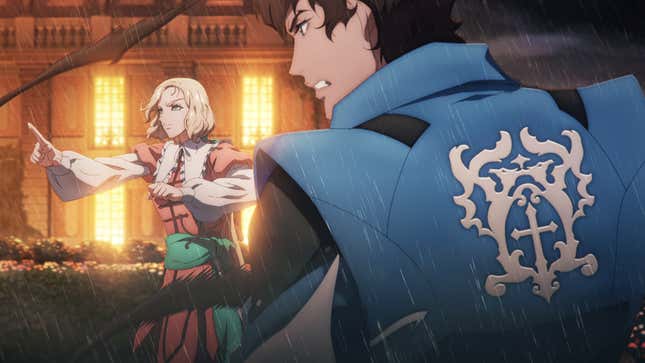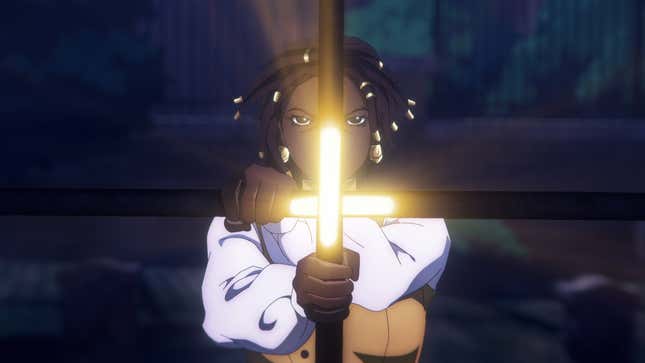Castlevania: Nocturne, the sequel series to Konami’s popular animated vampire saga, Castlevania, recaptures the magic that its predecessor brought to the dance back in 2017. A tightly written show with multifaceted heroes and villains, outstanding action sequences, and imaginative monster designs, its meticulously constructed dialogue will have you hanging off of every word. Simply put, Castlevania: Nocturne makes sure that nearly every scene in its eight-episode season is equal parts purposeful, engaging, and beginner-friendly to viewers who may have missed the original series.
The show, which takes place 300 years after Castlevania and loosely adapts the PC Engine classic Castlevania: Rondo of Blood, is set during the height of the French Revolution in 1792, and follows Richter Belmont, a descendant of Trevor Belmont and Sypha Belnades, who, alongside his adoptive sister Maria Renard, fight to stop a tyrannical “Vampire Messiah.” The pair have the cards stacked against them because the big bad, Erzsebeth Báthory—who’s based on the folklore surrounding a real-life historical figure—has allied herself with counter-revolutionary aristocrats and key political figures around the world, and plans on using her ungodly powers to blot out the sun so vampires can terrorize the world at their leisure. Suffice it to say, this generation of vampire hunters has one hell of a task ahead of them and the show doesn’t shy away from showcasing them being out of their depth.
Read More: Castlevania: Nocturne’s New Trailer Drips With Action, Incredible Animation
Advertisement
Rather than setting up Maria and Richter to be hyper-capable carbon copies of their predecessors, as popular generation-spanning anime like Naruto are wont to do, the show instead opts to underscore how their inexperience puts them on the backfoot during nearly every deadly encounter in the show. Unlike Sypha and Trevor, who we meet as fully realized adults in the midst of their epic and perilous quest, Maria, Richter, and their newfound allies Annette and Edouard possess a youthful eagerness to rush into the fray headfirst without a tangible plan, and it backfires. After all, Richter is only 19 years old and hasn’t been tasked with saving the world as often as his ancestors have, so it’s to be expected that he’ll have some growing pains as a hero.
Nocturne’s greatest strength is how it allows its heroes to be vulnerable. While Trevor’s sardonic swagger in Castlevania comes as a result of him weathering years of failure and pyrrhic victories, Richter’s haughtiness derives from his fear that he won’t be strong enough to save the ones he loves. Basically, Richter is the embodiment of the Mike Tyson quote, “Everybody has a plan until they get punched in the mouth.” His metaphorical sucker punch comes in the form of Olrox, a charismatic Aztec vampire who murdered his mother when he was a boy, traumatizing him to the point that he can no longer use magic and freezes up in fear or flees whenever Olrox makes a sudden appearance.
Advertisement
Advertisement

Richter’s cowardice never comes off as grating, but instead humanizes him by making him a fallible hero who still has a lot to learn before he can face Erzsebeth or Olrox. Personally, I found it beautiful that Nocturne’s hard-knocks coming-of-age tale for Richter let him cry on multiple occasions as he worked through his trauma, something anime protagonists are rarely allowed to do. Rest assured, Richter inevitably comes out the other end as the hero that fans of the Castlevania games have come to love, and he does so in a gratifying way that pays off toward the midway point of the season.
Nocturne isn’t afraid of letting its side characters bask in the limelight, too
Much like how Castlevania transformed Isaac the forge master into the most compelling character in the show, so too does Nocturne with Annette and Edouard, newfound allies of Richter and Maria’s. While the French Revolution provides set dressing for Richter and Maria’s fight against Erzsebeth and her cronies, the show also weaves in the Haitian Revolution, letting its Black characters partake and triumph in their own revolutionary struggle.
Advertisement

Read More: Castlevania’s Emancipation Of Isaac Stole The Entire Show
In episode three, Freedom Is Sweeter, written by Zodwa Nyoni, we learn that Annetteescaped from slavery in Haiti, where the slave trade was under the vampiric rule of Erzsebeth and her French regime, and partook in the Haitian Revolution using Creole incantations to aid Saint-Domingue ’s freedom fighters. It’s in this episode that we also discover how she and Edouard, a talented opera singer who initially felt at odds with the show’s grimdark premise, used his status as a commodity and a free man to aid Annette in her escape from a slave plantation after the brutal death of her mother. This episode is a clear standout this season, brilliantly meshing real-life events with Castlevania’s fantastical lore. Nocturne does something rare and extraordinary by making these Black characters, who in the hands of another anime might have been fridged to motivate its Caucasian heroes, the emotional lifeblood of the series, even as it establishes the pair as effective narrative foils to Maria and Richter.
Advertisement
Castlevania: Nocturne’s first season lays the groundwork for a series that has the potential to eclipse the greatness of its predecessor while raising the bar for video game adaptations in the process.






